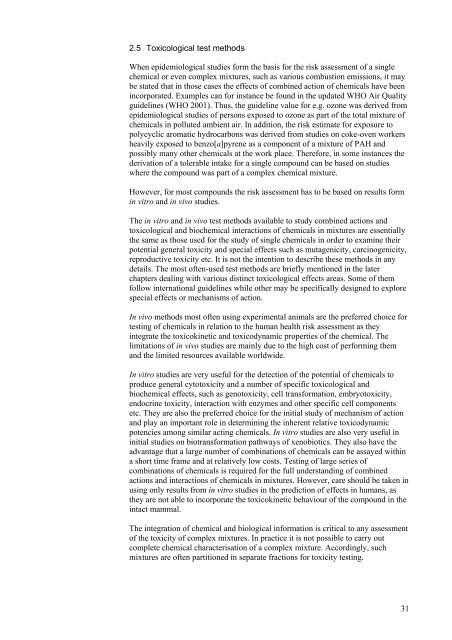Combined Actions and Interactions of Chemicals in Mixtures
Combined Actions and Interactions of Chemicals in Mixtures
Combined Actions and Interactions of Chemicals in Mixtures
Create successful ePaper yourself
Turn your PDF publications into a flip-book with our unique Google optimized e-Paper software.
2.5 Toxicological test methods<br />
When epidemiological studies form the basis for the risk assessment <strong>of</strong> a s<strong>in</strong>gle<br />
chemical or even complex mixtures, such as various combustion emissions, it may<br />
be stated that <strong>in</strong> those cases the effects <strong>of</strong> comb<strong>in</strong>ed action <strong>of</strong> chemicals have been<br />
<strong>in</strong>corporated. Examples can for <strong>in</strong>stance be found <strong>in</strong> the updated WHO Air Quality<br />
guidel<strong>in</strong>es (WHO 2001). Thus, the guidel<strong>in</strong>e value for e.g. ozone was derived from<br />
epidemiological studies <strong>of</strong> persons exposed to ozone as part <strong>of</strong> the total mixture <strong>of</strong><br />
chemicals <strong>in</strong> polluted ambient air. In addition, the risk estimate for exposure to<br />
polycyclic aromatic hydrocarbons was derived from studies on coke-oven workers<br />
heavily exposed to benzo[a]pyrene as a component <strong>of</strong> a mixture <strong>of</strong> PAH <strong>and</strong><br />
possibly many other chemicals at the work place. Therefore, <strong>in</strong> some <strong>in</strong>stances the<br />
derivation <strong>of</strong> a tolerable <strong>in</strong>take for a s<strong>in</strong>gle compound can be based on studies<br />
where the compound was part <strong>of</strong> a complex chemical mixture.<br />
However, for most compounds the risk assessment has to be based on results form<br />
<strong>in</strong> vitro <strong>and</strong> <strong>in</strong> vivo studies.<br />
The <strong>in</strong> vitro <strong>and</strong> <strong>in</strong> vivo test methods available to study comb<strong>in</strong>ed actions <strong>and</strong><br />
toxicological <strong>and</strong> biochemical <strong>in</strong>teractions <strong>of</strong> chemicals <strong>in</strong> mixtures are essentially<br />
the same as those used for the study <strong>of</strong> s<strong>in</strong>gle chemicals <strong>in</strong> order to exam<strong>in</strong>e their<br />
potential general toxicity <strong>and</strong> special effects such as mutagenicity, carc<strong>in</strong>ogenicity,<br />
reproductive toxicity etc. It is not the <strong>in</strong>tention to describe these methods <strong>in</strong> any<br />
details. The most <strong>of</strong>ten-used test methods are briefly mentioned <strong>in</strong> the later<br />
chapters deal<strong>in</strong>g with various dist<strong>in</strong>ct toxicological effects areas. Some <strong>of</strong> them<br />
follow <strong>in</strong>ternational guidel<strong>in</strong>es while other may be specifically designed to explore<br />
special effects or mechanisms <strong>of</strong> action.<br />
In vivo methods most <strong>of</strong>ten us<strong>in</strong>g experimental animals are the preferred choice for<br />
test<strong>in</strong>g <strong>of</strong> chemicals <strong>in</strong> relation to the human health risk assessment as they<br />
<strong>in</strong>tegrate the toxicok<strong>in</strong>etic <strong>and</strong> toxicodynamic properties <strong>of</strong> the chemical. The<br />
limitations <strong>of</strong> <strong>in</strong> vivo studies are ma<strong>in</strong>ly due to the high cost <strong>of</strong> perform<strong>in</strong>g them<br />
<strong>and</strong> the limited resources available worldwide.<br />
In vitro studies are very useful for the detection <strong>of</strong> the potential <strong>of</strong> chemicals to<br />
produce general cytotoxicity <strong>and</strong> a number <strong>of</strong> specific toxicological <strong>and</strong><br />
biochemical effects, such as genotoxicity, cell transformation, embryotoxicity,<br />
endocr<strong>in</strong>e toxicity, <strong>in</strong>teraction with enzymes <strong>and</strong> other specific cell components<br />
etc. They are also the preferred choice for the <strong>in</strong>itial study <strong>of</strong> mechanism <strong>of</strong> action<br />
<strong>and</strong> play an important role <strong>in</strong> determ<strong>in</strong><strong>in</strong>g the <strong>in</strong>herent relative toxicodynamic<br />
potencies among similar act<strong>in</strong>g chemicals. In vitro studies are also very useful <strong>in</strong><br />
<strong>in</strong>itial studies on biotransformation pathways <strong>of</strong> xenobiotics. They also have the<br />
advantage that a large number <strong>of</strong> comb<strong>in</strong>ations <strong>of</strong> chemicals can be assayed with<strong>in</strong><br />
a short time frame <strong>and</strong> at relatively low costs. Test<strong>in</strong>g <strong>of</strong> large series <strong>of</strong><br />
comb<strong>in</strong>ations <strong>of</strong> chemicals is required for the full underst<strong>and</strong><strong>in</strong>g <strong>of</strong> comb<strong>in</strong>ed<br />
actions <strong>and</strong> <strong>in</strong>teractions <strong>of</strong> chemicals <strong>in</strong> mixtures. However, care should be taken <strong>in</strong><br />
us<strong>in</strong>g only results from <strong>in</strong> vitro studies <strong>in</strong> the prediction <strong>of</strong> effects <strong>in</strong> humans, as<br />
they are not able to <strong>in</strong>corporate the toxicok<strong>in</strong>etic behaviour <strong>of</strong> the compound <strong>in</strong> the<br />
<strong>in</strong>tact mammal.<br />
The <strong>in</strong>tegration <strong>of</strong> chemical <strong>and</strong> biological <strong>in</strong>formation is critical to any assessment<br />
<strong>of</strong> the toxicity <strong>of</strong> complex mixtures. In practice it is not possible to carry out<br />
complete chemical characterisation <strong>of</strong> a complex mixture. Accord<strong>in</strong>gly, such<br />
mixtures are <strong>of</strong>ten partitioned <strong>in</strong> separate fractions for toxicity test<strong>in</strong>g.<br />
31

















